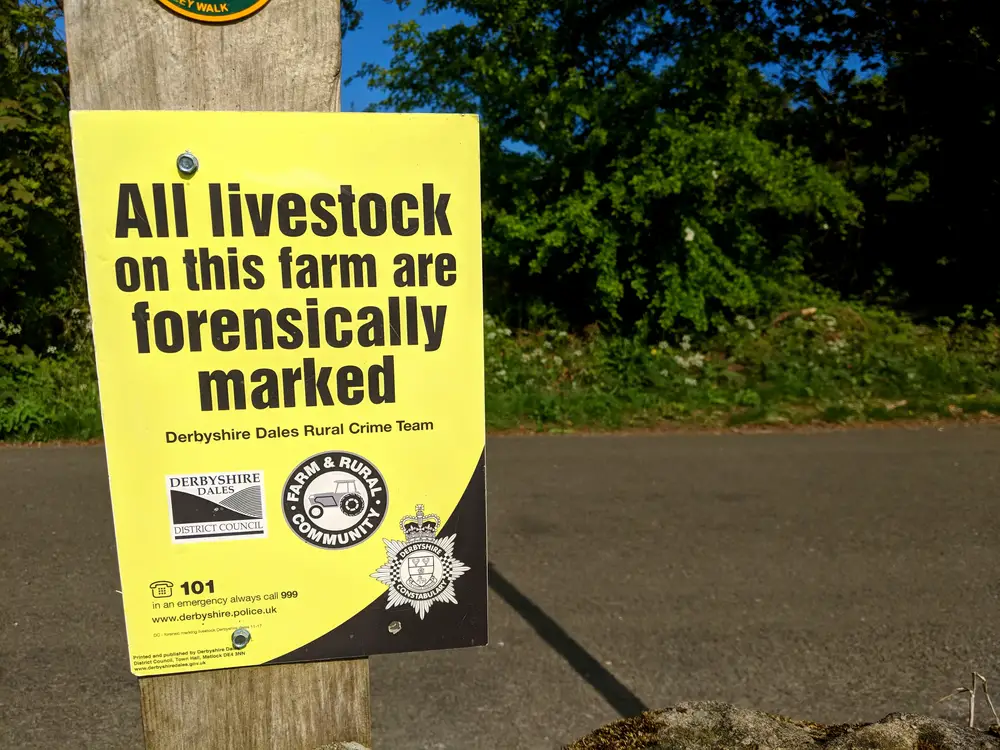Cattle rustling (cattle theft) still exists and costs the cattle industry millions of dollars per year. It's just no longer the romanticized version we remember from the old western movies. Today, thieves are taking full advantage of modern-day technology to ply a trade as old as cattle farming itself.
Rustling has resurged in traditional American cattle heartlands like Texas, Nebraska, Kansas, and Oklahoma.
However, while cattle raiders take advantage of 21st-century technology, such as quad bikes and GPS, farmers too can use high-tech equipment to their advantage. Electronic tagging, sophisticated surveillance equipment, and mobile devices that enable quick communication between neighboring farmers help redress the balance at least a little in their favor.
Table of Contents
The Problem in East Africa
The most violent and extreme livestock theft has occurred in Africa in recent years. Africa has terrible problems with cattle theft, especially in Uganda, Kenya, and South Sudan.
These countries are perfect for cattle raiding with wide-open spaces and isolated farms.
More importantly, there are very lax border-control restrictions and almost non-existent legislative coordination between countries. These conditions make it relatively straightforward for the rustlers to move and sell the cattle afterward, even if it involves cross-border transport.
Fact 1: African cattle raiding is taking on an even more sinister aspect, with terrorist groups such as Boko Haram increasingly interested in the easy and lucrative rewards that rustling can offer.

Fact 2: Many rural east Africans traditionally see cattle theft as aspirational and part of a warrior’s way of life. It has always been considered a socially acceptable way of restocking your herd after periods of drought, and village elders will even bless rustlers as a part of rituals that have gone on for centuries.
African cattle rustlers frequently use AK47s and motorbikes when stealing livestock.
Cattle Rustling and Selling On Afterwards
A lot of farmers feed their cattle from the back of their trucks. It’s relatively straightforward to copy this process and lead the cows directly into the back of your waiting trailer. Putting a little feed onto the trailer floor makes walking in there even more inviting, and when one cow goes in, the rest will follow.
Fact 3: Farmers inadvertently make it easier for cattle thieves by building corrals on their land. These corrals bunch the animals and prevent them from spreading out or escaping while being rustled.
If you calculate that a head of cattle can bring anything from US$1,000 to US$3,000, stealing five cows can bring anything up to US$15,000. More than enough for quite a few fixes and easy money if the rustler has set up a private buyer on a ranch somewhere.
Even if the thief has to sell the cattle personally, selling the stolen cattle at market is not as difficult as it should be. There is not a legal framework to support regulatory control at livestock auctions. As long as the name and address check out – something a thief can quite easily make possible – the bogus vendor can sell the cattle quickly and conveniently and then move on to the next heist.
Farmers Still Suspicious of “The Man”
It is difficult to prosecute thieves, but the best way to recover stolen cattle is by increasing regulation at livestock markets.
Several states now have “brand inspectors” who patrol the holding pens and register every animal passing through the cattle auction. They look for earmarks, horns, brands, and other distinguishing characteristics.
Agents will inform the inspectors of every case of missing cattle and will notify police officers if they spot something unusual.
State law enforcement tries to promote the advantages of branding and chipping. However, many farmers are still unwilling to embrace change, especially anything related to bureaucracy or technology.

Consequently, there is a general unwillingness in the agricultural industry to use microchips or enroll in state- or federally-controlled directories.
“Breaking Bad” on The Pastures
Cattle rustling is increasing in the heart of the U.S. cattle industry, mainly driven by local young men and even ranch hands stealing livestock to feed their drug habits.
Indeed, law enforcement puts a lot of this rise down to the dizzying increase in recreational drug use, such as heroin, and especially methamphetamine.
Fact 4: In 2015, when cattle rustling was still increasing in Oklahoma, 70-80% of the outlaws admitted cattle-rustling fueled their methamphetamine habit.
When a drug user in a rural area chooses a way to fund their habit, the risk-reward involved in cattle rustling is extremely attractive. Picking off a few cattle grazing on an isolated pasture with nobody around to disturb you is particularly attractive. You can also throw in the added advantage of cattle being generally compliant and used to human interaction.
Cattle rustling is still primarily a rural problem, and drugs are not the only reason raiding still continues. Ongoing economic hardship in traditionally agricultural areas provides individuals with less sinister reasons for turning to cattle crime.
Simply putting food on the table for the family can be a formidable motivator.
Drought is a major problem in cattle country. It reduces the areas of pasture the cattle feed on and leads to farmers cutting the size of their herds to prevent overgrazing. The consequent reduction in the number of cattle has driven up prices and made cattle theft a more enticing prospect.
Modern-Day “Gangster Rustlers”
Towards the end of the 1970s, we saw the emergence of a new, more sophisticated cattle thief. These bandits would usually target smaller-scale ranches, steal about half a dozen cattle, and go straight to a livestock auction with them.

Fact 5: Today, rustlers have become even more evolved and ruthless. Reports state that some use tranquilizer guns, specially-trained dogs to chase and corral the cattle, and even helicopters to herd the cows in some cases.
Oklahoma Cattle Cops
Some states have decided to fight fire with fire to combat these super rustlers.
To counter the rise in rustling, the Oklahoma Department of Agriculture, Food and Forestry (ODAFF) has created a unit of special agents to travel the roads of Oklahoma in search of rustlers. This specialized team of “cattle cowboys” investigates around 300 cases annually.
Over the last few years, Oklahoma has experienced steady increases in cattle thefts across the state. Some industry experts estimate the losses to add up to millions of dollars.
Fact 6: On average, over 1,000 cattle are reported missing annually in Oklahoma, according to The Oklahoma Cattlemen’s Association. At US$3,000 a head, that adds up to US$3m!
The losses only make up a fraction of the US$5 billion the industry generates annually. However, losing livestock can disastrously affect a rancher working an 18-hour day and surviving on narrow profit margins.
Unfortunately, law enforcement only recovers about half of the stolen cattle.
The ODAFF stated the rate of cattle theft grew by over 500% at the start of the previous decade, with losses state-wide averaging close to 150 per head a month. It is still increasing, although not at the same rate.
Rustling used to be punishable by hanging. Nowadays, it will mean a stretch in jail of between 3 and 10 years in Oklahoma. Texas views cattle theft as a third-degree felony, the lowest grade of felonies, and, correspondingly, the prison sentence is slightly less than that of Oklahoma.
Texas Law Enforcement For Cattle
These “cow cops” are more numerous in Texas and the Southwest because it is such a vast area.
Fact 7: The huge Texas and Southwestern Cattle Raisers Association has taken extraordinary measures to counter this increased threat by taking on 30 deputized special rangers to help with the problem. They reunite thousands of cattle with their owners every year.
The association has a membership of around 17,000 farming, approaching four million cattle, and has employed these rangers since the early 20th century.
Fact 8: The task force deals with approximately 1,000 cattle-related crimes a year involving nearly 4,000 head of cattle. They estimate the recovery of almost US$6m worth of livestock and farming equipment annually.
Theft To Sale in Just a Few Hours
One farmer tells of an incident where thieves put their security lighting out of action and herded the cows in a corral, probably using cattle feed to attract them.
Fact 9: In only a short time, they had herded 15 head of cattle onto a truck and taken them to a market around an hour’s drive from the farm. Once at the auction, the cattle raised nearly US$15,000 in just a matter of hours.
This short turnaround is one of the big problems for local law enforcement units. It sometimes takes a few days for ranchers to notice cattle are missing; by this time, the rustlers are long gone.
Another rancher said, “You lose the sale price of the cow, of course. But it also took you five years to get her born, get her raised, get her bred and get a new calf and all the investment that entails. It’s also about what she’s going to produce in the next five to ten years.”
Fact 10: Cattle will bring about a thousand dollars a head at auction, and unfortunately, 9 times out of 10, a thief will receive full price. As we have already read, regulations at cattle auctions can be extremely lax.
